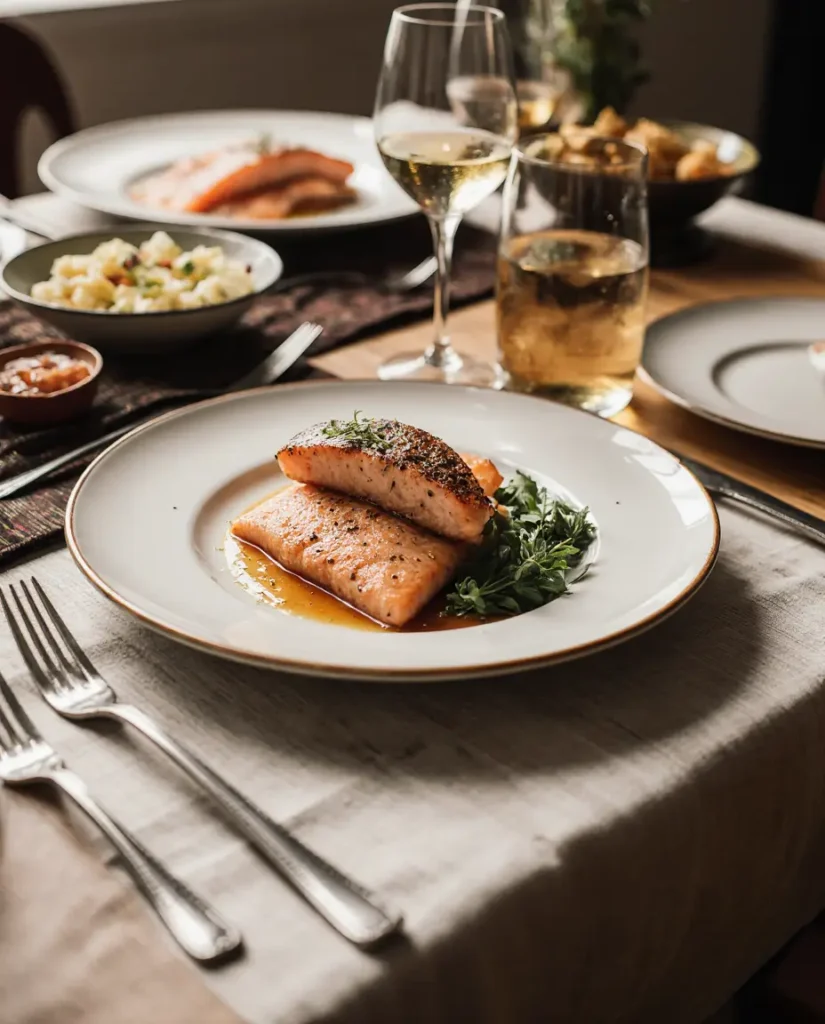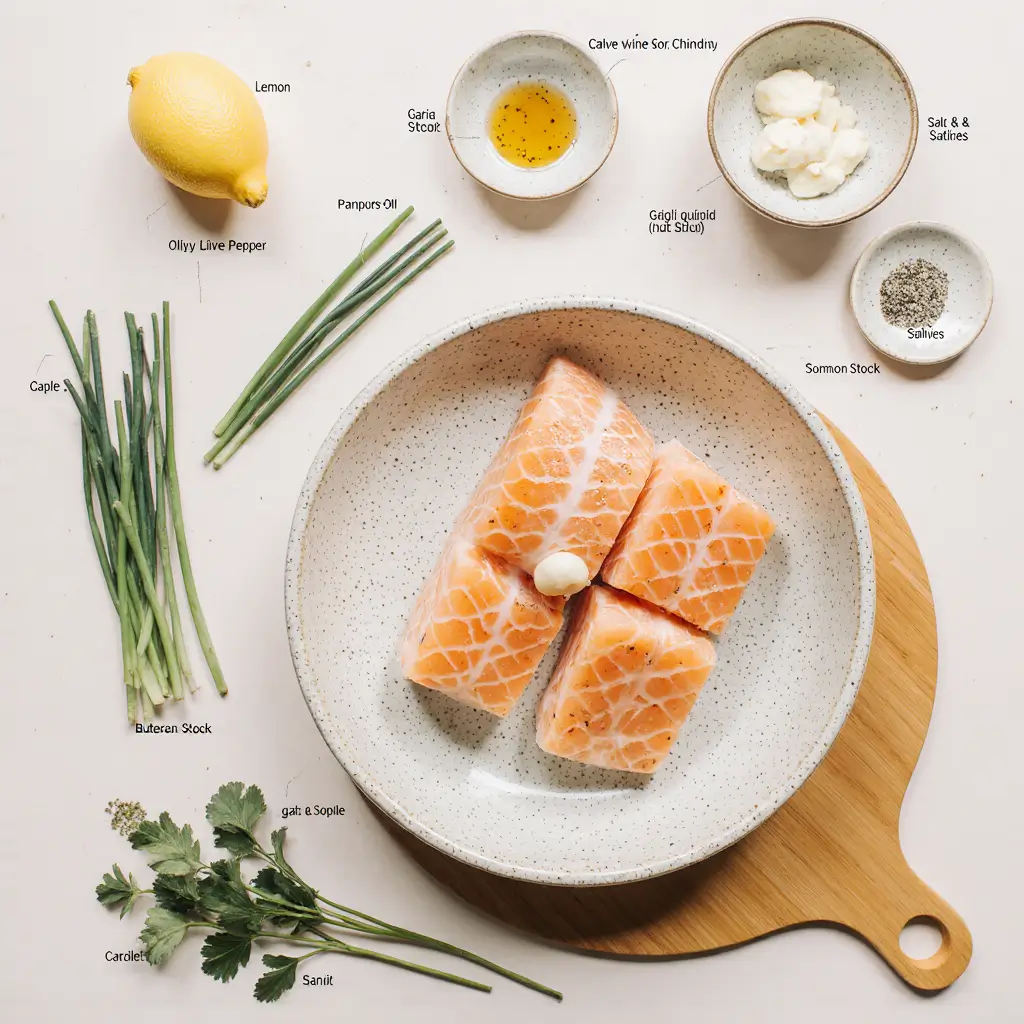
Table of Contents
Key Insights for Salmon Steaks Mastery
- Fillets vs. Steaks: Salmon fillets are boneless, lengthwise cuts ideal for quick cooking, while salmon steaks include bone and are cross-sectional.
- Flavorful Enhancements: Elevate your salmon with simple additions like garlic butter, fresh herbs, and citrus, or explore aromatic lemongrass for a unique twist.
- Cooking Versatility: Grilling, pan-searing, and baking are all excellent methods, each offering distinct textures and flavors, ensuring a perfect result every time.
Salmon fillet recipes are a beloved choice for home cooks across America, prized for their rich flavor, vibrant color, and tender, flaky texture. Whether you’re exploring the nuances of “Salmon on the Bone” or perfecting your “Grilled Salmon Fillet,” this comprehensive guide will walk you through everything you need to know. From understanding the distinct characteristics of salmon fillets to mastering quick and easy cooking methods, you’ll be well on your way to preparing delicious, juicy salmon every time.
Understanding Salmon Steaks: More Than Just Fish
What defines a salmon fillet and how it stands apart.
A salmon fillet is a boneless cut of salmon that runs parallel to the spine, carefully removed from the backbone. This results in a clean piece of fish that is exceptionally easy to prepare and eat. Unlike salmon steaks, which are cut perpendicular to the spine and include a segment of bone and often skin, fillets are prized for their delicate, flaky texture and convenience. Salmon fillets are typically a thicker, center-cut portion, often with the skin left on one side, making them both juicy and visually appealing as a main course.
Salmon Fillets vs. Other Fish Fillets
While all salmon fillets are technically fish fillets, not all fish fillets are created equal. Salmon fillets are particularly renowned for their thick, meaty texture and rich, high-fat content. This elevated oil content translates directly to superior flavor and moistness, especially when cooked properly. In contrast, fish like cod, tilapia, or flounder offer lighter, milder fillets that cook more quickly and lend themselves to different culinary applications. If you’re seeking a hearty, luxurious fillet with a robust flavor, salmon is an unparalleled choice.
Navigating Salmon with Bone: “Salmon Steaks on the Bone”
Although salmon fillets are typically boneless, some may still contain small, thin bones known as “pin bones.” These run along the side of the fillet and can be easily removed with kitchen tweezers or needle-nose pliers before cooking. However, when discussing “salmon on the bone,” it usually refers to a salmon steak or a larger cut where the backbone and other bones are intentionally left intact. Cooking fish on the bone, including salmon, is believed to help retain moisture and impart a richer flavor due to the bones acting as natural insulators and adding density during the cooking process. If you opt for salmon on the bone, ensure a thorough cook and consider basting to maintain moisture.
Essential Ingredients for Succulent Salmon Steaks

Building blocks for any delicious salmon creation.
To embark on your salmon culinary journey, a few simple yet essential ingredients will suffice. These versatile components form the foundation for numerous salmon fillet recipes, allowing you to create diverse and flavorful dishes with ease.
| Ingredient | Quantity (for 4 servings) | Purpose/Notes |
|---|---|---|
| Salmon Fillets | 4 portions (approx. 6-8 oz each) | Preferably wild-caught for deeper flavor, or farmed for consistent fattiness. Skin-on is recommended for crispiness. |
| Olive Oil | 2-3 tablespoons | For searing, grilling, baking, and preventing sticking. |
| Salt & Freshly Ground Black Pepper | To taste | Fundamental seasoning to enhance natural flavors. |
| Lemon | 1, sliced or juiced | Adds brightness and cuts through richness. |
| Butter | 2 tablespoons | For richness, basting, and creating garlic butter. |
| Garlic | 2-3 cloves, minced | Aromatic base for savory preparations. |
| Fresh Herbs | Dill, parsley, or cilantro | Finishing touch for freshness and aroma. |
| Optional Spices/Flavorings | Paprika, chili flakes, fresh ginger, lemongrass, soy sauce, honey | For adding complexity and adapting to various cuisines. |
Mastering Quick & Easy Cooking Methods
Achieving perfectly cooked salmon with confidence.
Whether you prefer a smoky char, a crispy skin, or a tender, baked texture, these three methods will guide you to a perfectly cooked salmon fillet every time. Each technique highlights different aspects of salmon’s versatility and can be adapted for both fillets and salmon on the bone.
Grilled Salmon Fillet: Smoky Perfection
Grilling salmon fillets brings out their natural smokiness and creates a beautifully crispy skin while keeping the center moist. This method is particularly well-suited for outdoor cooking and imparts a distinct char that enhances the salmon’s rich flavor.
- Preparation: Preheat your grill to medium-high heat (375–400°F). Lightly oil the grill grates to prevent sticking. Brush the salmon fillets with olive oil, season generously with salt, pepper, and your chosen herbs or spices. For optimal flavor and adhesion, allow them to rest for 10–15 minutes after seasoning.
- Grilling: Place the fillets skin-side down on the preheated grill. Cook for 4–6 minutes without moving, allowing the skin to crisp and develop a beautiful char. Carefully flip the fillets and continue cooking for an additional 2–3 minutes, or until the flesh is just opaque in the center and flakes easily with a fork.
- Serving: Garnish with fresh lemon wedges and a sprinkle of fresh dill or parsley. For an extra boost of flavor, top with a pat of homemade garlic butter or a sprinkle of finely chopped lemongrass after grilling.
A raw salmon fillet, marinated with olive oil, herbs, and sliced lemon, resting on a wooden cutting board.

Pan-Seared Salmon Steaks : Crispy Skin, Tender Interior
Pan-searing is an ideal method for achieving a restaurant-quality crispy skin and a moist, tender interior, making it perfect for a quick weeknight dinner. The direct heat of the pan caramelizes the skin beautifully.
- Preparation: Pat your salmon fillets thoroughly dry with paper towels to ensure a good sear. Season both sides generously with salt and pepper. Heat a heavy-bottomed skillet (cast iron or stainless steel works best) over medium-high heat and add 1-2 tablespoons of olive oil or butter.
- Searing: Once the oil is shimmering, carefully place the salmon fillets skin-side down in the hot pan. Press gently on the fillets for the first 30 seconds to ensure full contact with the pan and help the skin crisp evenly. Sear for 3–4 minutes until the skin is deeply golden and crispy.
- Finishing: Carefully flip the fillets. Reduce the heat to medium. If desired, add minced garlic or butter to the pan and baste the salmon for another 1–2 minutes, or until cooked through. The internal temperature should reach 145°F (63°C).
- Resting: Remove from the pan and let the salmon rest for 2 minutes before serving to allow the juices to redistribute, ensuring maximum moistness.
Baked Salmon Fillet: Effortless Elegance
Baking salmon is a foolproof and hands-off method that results in evenly cooked, moist salmon, making it an excellent choice for infusing flavors with minimal effort. It’s particularly forgiving for beginners.
- Preparation: Preheat your oven to 400°F (200°C). Line a baking sheet with parchment paper or aluminum foil for easy cleanup. Arrange your seasoned salmon fillets on the prepared baking sheet.
- Baking: Drizzle the fillets with olive oil, season with salt, pepper, and your favorite herbs. For added flavor and moisture, you can place lemon slices directly on top of the fillets during baking. Bake for 12–15 minutes, depending on the thickness of the fillets. The salmon is done when it flakes easily with a fork or reaches an internal temperature of 145°F (63°C).
- Flavor Boost: After baking, a squeeze of fresh lemon juice or a dollop of garlic butter can elevate the dish significantly.

A perfectly grilled salmon fillet, skin crisp and golden, served on a platter with lemon slices and fresh herbs.
Flavor Boosters and Moisture Retention
Enhancing taste and ensuring tender results.
Beyond basic seasoning, certain ingredients and techniques can significantly elevate the flavor profile of your salmon and ensure it remains incredibly moist. These tips are invaluable whether you’re working with boneless fillets or “salmon on the bone.”
Unleashing Flavor: Garlic Butter & Lemongrass
- Garlic Butter: A timeless classic, garlic butter adds incredible richness and savory depth. Simply melt butter with minced garlic and a pinch of salt. Spoon this mixture over hot salmon after cooking, or use it for basting during pan-searing or baking. It creates a luxurious sauce that complements salmon beautifully.
- Lemongrass: For a bright, aromatic, and slightly exotic twist, incorporate finely chopped fresh lemongrass. Mix it with olive oil, salt, and pepper to create a unique marinade, or add it to your garlic butter for an Asian-inspired flavor profile. The subtle citrus notes of lemongrass pair exceptionally well with the richness of salmon.
- Citrus and Herbs: Don’t underestimate the power of fresh lemon, orange, or lime zest, along with fresh herbs like dill, parsley, cilantro, thyme, or basil. These ingredients add essential brightness and balance to salmon’s natural richness.
Keeping Salmon Moist, Especially “Salmon on the Bone”
Overcooking is the primary culprit behind dry salmon. Here’s how to ensure your salmon, particularly if it’s “on the bone,” remains juicy and flaky:
- Don’t Overcook: Salmon is best when it’s just opaque in the center. The ideal internal temperature for cooked salmon is 145°F (63°C). Using an instant-read thermometer is the most reliable way to prevent overcooking. Remember, fish continues to cook slightly after being removed from the heat.
- Remove Pin Bones: For boneless fillets, always check for and remove any lingering pin bones before cooking. These small bones can disrupt the eating experience. You can typically feel them by running your fingers along the raw fillet.
- Marinate or Rub: A simple oil-based marinade or rub (with lemon, herbs, and spices) helps create a protective barrier and infuses flavor, contributing to moisture retention.
- Skin-On Cooking: Cooking salmon with the skin on, particularly when grilling or pan-searing, helps lock in moisture. The skin crisps up beautifully and acts as a natural insulator.
- Basting: For pan-seared or baked salmon, regularly spooning the pan juices or melted butter over the fish as it cooks helps keep it moist and adds flavor.
- Resting: Just like meat, salmon benefits from resting for a few minutes after cooking. This allows the juices to redistribute throughout the fillet, resulting in a more tender and moist outcome.
Complementing Your Salmon: Ideal Side Dishes
Perfect pairings to elevate your meal.
Salmon’s rich flavor and meaty texture make it incredibly versatile when it comes to side dishes. The key is to select accompaniments that either complement its richness or provide a refreshing contrast, balancing the overall meal.
- Roasted Vegetables: Asparagus, broccoli, Brussels sprouts, or green beans are excellent choices. Roasting brings out their natural sweetness and a slight char that pairs wonderfully with salmon.
- Leafy Greens: A simple arugula or spinach salad with a light citrus vinaigrette offers a fresh, peppery contrast to the salmon’s richness.
- Grains: Quinoa, wild rice, couscous, or farro pilaf provide a satisfying and healthy base, absorbing any delicious pan juices or sauces.
- Potatoes: Creamy mashed potatoes, crispy roasted potatoes, or a light potato salad (lemon-dill is a great match) offer comforting and hearty options.
- Sauces: Consider a simple dill yogurt sauce, a classic beurre blanc, or a quick pan sauce made from the cooking drippings with a splash of wine or broth.
The radar chart above provides a comparative overview of salmon fillets versus salmon on the bone across several key culinary attributes. It visually represents how salmon fillets generally excel in ease of preparation, flavor versatility, and the potential for crispy skin, making them a go-to for quick and impressive meals. Conversely, salmon on the bone often offers superior moisture retention and can contribute more depth of flavor, albeit with a slightly longer cooking time and more involved preparation. Both options offer high nutritional value, making either a healthy choice depending on your priorities and cooking style.
Visualizing Salmon Preparation Stages
A mindmap of the salmon cooking process.
To further clarify the journey from raw salmon to a delicious meal, this mindmap illustrates the key stages and considerations in preparing salmon fillets. It outlines the core decisions and actions involved, from selection to serving, ensuring a streamlined cooking experience.Salmon
Fillet PreparationSelectionWild vs. FarmedFreshness IndicatorsSkin On/Off ConsiderationsPreparationPin Bone RemovalSeasoningSalt & PepperHerbs & SpicesMarinades/RubsCooking MethodsGrillingMedium-High HeatSkin-Side Down FirstMonitor DonenessPan-SearingHigh Heat SearCrispy Skin FocusBasting OptionBakingPreheat OvenParchment/Foil LinedEven CookingFlavor EnhancementsGarlic ButterLemongrassCitrus Zest & JuiceFresh HerbsMoisture RetentionDon’t OvercookInternal Temp CheckResting After CookingIdeal Side DishesRoasted/SteamedVegetablesGrains (Quinoa, Rice)Fresh SaladsPotatoes
Choosing Your Cooking Method: A Performance Snapshot
Comparing the popular cooking techniques for salmon.
Different cooking methods for salmon have varying benefits, affecting their texture, flavor, and cooking time. We present common methods based on several performance indicators, helping you choose the most appropriate method for achieving your desired result.
We show you the comparative performance of grilling, pan-searing, and baking salmon. Pan-searing generally offers crispiness and saves time, making it ideal for a quick, restaurant-quality crust. Baking retains moisture and is easy to clean, making it ideal for a tender, no-fuss cooking method. Grilling provides the deepest flavor thanks to a smoky flavor, striking a good balance between several factors, although cleanup can be more involved than baking. Each method has its own advantages, allowing you to customize your cooking options based on your preferences and available time.
Learn How to Remove Pin Bones from Salmon
A crucial step for a seamless dining experience.
Removing pin bones from salmon fillets is a simple yet vital step to ensure a smooth, enjoyable eating experience. These small, flexible bones are often present even in what’s sold as a “boneless” fillet. The process is quick and easy, requiring only a pair of kitchen tweezers or needle-nose pliers.
First, lay your salmon fillet skin-side down (if applicable) on a clean surface. Run your fingers gently along the length of the fillet, feeling for any small, hard bumps. These are the ends of the pin bones. Once you locate a bone, grasp it firmly with your tweezers and pull it out at an angle, in the direction of the fish’s natural grain. This technique helps ensure the flesh doesn’t tear unnecessarily. Repeat this process until you can no longer feel any bones. This quick preparation step guarantees a perfectly smooth texture in your cooked salmon, enhancing every bite.
Chef Nicholas Gavin demonstrates the precise technique for locating and removing pin bones from a salmon fillet, a critical step for preparing a flawless piece of fish.
This video is highly relevant as it directly addresses a common challenge in preparing salmon fillets: the removal of pin bones. It provides a clear, visual demonstration of how to perform this task efficiently and effectively, which is crucial for achieving a truly boneless and enjoyable salmon dish. The chef’s technique ensures that the fillet remains intact and aesthetically pleasing, reinforcing the importance of proper preparation before cooking.
Frequently Asked Questions About Salmon Fillets
What is the ideal internal temperature for cooked salmon?
How can I tell if salmon is cooked without a thermometer?
Should I cook salmon with the skin on or off?
What’s the difference between wild-caught and farmed salmon?
How do I prevent my salmon from sticking to the grill or pan?
Conclusion: Your Path to Salmon Perfection
Mastering salmon fillet recipes is an incredibly rewarding culinary skill that is far easier than it may seem. By understanding the distinct qualities of salmon fillets, choosing quality ingredients, and employing the right cooking techniques—whether grilling, pan-searing, or baking—you can consistently achieve delicious, moist, and impressive results. Remember to embrace flavorful enhancements like garlic butter and lemongrass, and always prioritize proper doneness to prevent overcooking. With these insights and methods, you’re now equipped to create salmon dishes that are not only healthy but also bursting with flavor, making every meal a memorable occasion for your American audience.
Leave a Review
I love hearing from you! Submit your question or recipe review here. Your email address will not be published. Required fields are marked *
There are no reviews yet. Be the first one to write one.
